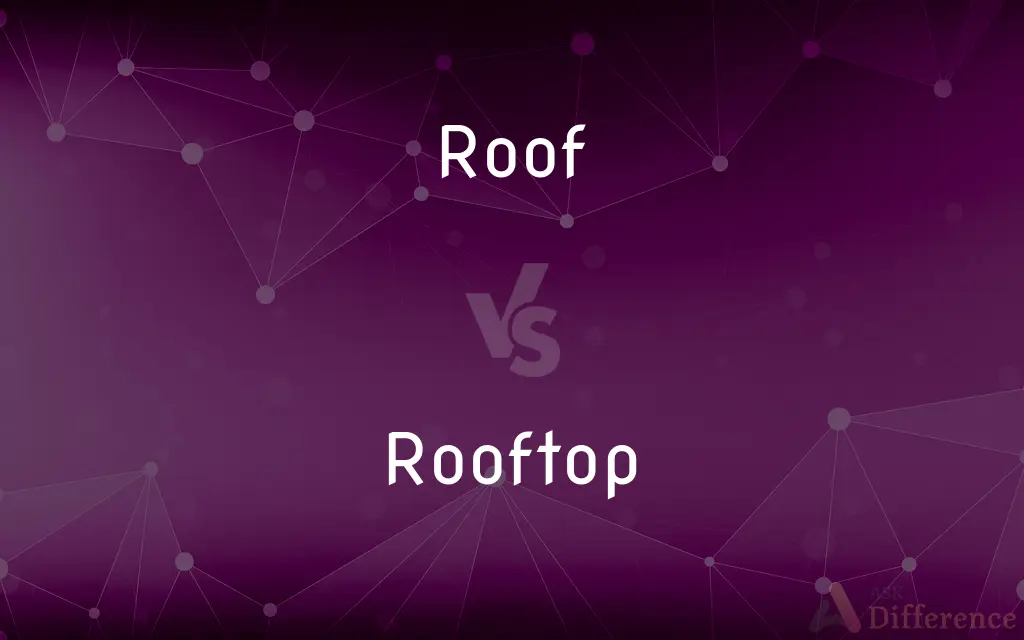Roof vs. Rooftop — What's the Difference?
By Fiza Rafique & Urooj Arif — Updated on April 1, 2024
Roof refers to the top covering of a building, designed for protection, while rooftop denotes the outer surface of a roof, often accessible or utilized for various purposes.

Difference Between Roof and Rooftop
Table of Contents
ADVERTISEMENT
Key Differences
The roof of a building is its uppermost layer, engineered to protect the structure from weather elements like rain, snow, and sun. It plays a crucial role in the overall integrity and insulation of a building. On the other hand, the rooftop refers specifically to the outer surface of the roof, which can be used for various activities such as gardening, gatherings, or as a place to install equipment like solar panels or air conditioning units.
In terms of construction and design, a roof can be made from a variety of materials including shingles, tiles, metal, or thatch, depending on the architectural style, climate, and functional requirements. Meanwhile, a rooftop might be designed with additional features to accommodate its use for leisure or utility purposes, such as reinforced flooring, safety railings, or green space.
From a functional perspective, the primary purpose of a roof is to offer protection and contribute to the energy efficiency of a building by keeping it warm in the winter and cool in the summer. Conversely, the rooftop serves as an extension of the living or operational space of a building, offering opportunities for recreation, additional storage, or alternative energy generation.
Accessibility is another distinguishing factor. Not all roofs are designed to be accessed regularly or safely by occupants, with some serving purely protective purposes. Rooftops, however, are often intentionally made accessible and may feature amenities like rooftop bars, restaurants, or gardens, emphasizing their role in providing usable outdoor space.
The terminology used when referring to these structures also varies by context. In real estate, the term "roof" may be used to describe the technical specifications and materials of a building’s top covering, whereas "rooftop" may be highlighted when emphasizing available outdoor space or amenities that add value to the property.
ADVERTISEMENT
Comparison Chart
Definition
The top covering of a building, designed for protection against the elements.
The outer surface of a roof, often used for activities or utility installations.
Function
Provides protection, insulation, and contributes to the structural integrity of a building.
Serves as accessible space for leisure, utility, or green initiatives.
Design and Materials
Constructed from materials like shingles, tiles, metal, based on need and style.
May include features like reinforced flooring, safety railings, or gardens.
Accessibility
Not all are designed for frequent access due to safety or design constraints.
Often designed to be accessible for various uses, with added amenities.
Contextual Use
Discussed in terms of construction, materials, and insulation properties.
Highlighted in real estate and design for its usability and added value.
Compare with Definitions
Roof
Variety of Materials.
The cabin featured a durable metal roof.
Rooftop
Accessible Outer Surface.
They hosted a party on the building's rooftop.
Roof
Integral Part of Building’s Structure.
The architect designed the roof with additional trusses for support.
Rooftop
Space for Leisure Activities.
The rooftop garden provides a peaceful retreat in the city.
Roof
Protection Against Weather.
The roof's insulation keeps the home warm in winter.
Rooftop
Extension of Living Space.
The rooftop deck offers spectacular views of the skyline.
Roof
Insulation and Energy Efficiency.
The green roof contributes to the building's energy efficiency.
Rooftop
Installation of Utility Equipment.
Solar panels on the rooftop contribute to the building's energy supply.
Roof
Uppermost Layer of a Building.
The house had a sloped roof to prevent snow accumulation.
Rooftop
Safety Features.
The rooftop is equipped with safety railings around its perimeter.
Roof
A roof is the top covering of a building, including all materials and constructions necessary to support it on the walls of the building or on uprights, providing protection against rain, snow, sunlight, extremes of temperature, and wind. A roof is part of the building envelope.
Rooftop
The outer surface of a roof.
Roof
The structure forming the upper covering of a building or vehicle
A car with a vinyl roof
A thatched roof
The rain woke him, hammering on the roof
Roof timbers
Rooftop
(somewhat formal) The area atop a roof.
Roof
The upper limit or level of prices or wages
Starting salary £12,185, rising to a roof of £16,835
Rooftop
The top layer of a roof; the material covering or composing a roof.
Roof
Cover with a roof
The yard had been roughly roofed over with corrugated iron
Rooftop
The top of a (usually flat) roof
Roof
The exterior surface and its supporting structures on the top of a building.
Roof
The upper exterior surface of a dwelling as a symbol of the home itself
Three generations living under one roof.
Roof
The top covering of something
The roof of a car.
Roof
The upper surface of an anatomical structure, especially one having a vaulted inner structure
The roof of the mouth.
Roof
The highest point or limit; the summit or ceiling
A roof on prices is needed to keep our customers happy.
Roof
To furnish with a roof or cover.
Roof
(architecture) The external covering at the top of a building.
The roof was blown off by the tornado.
Roof
The top external level of a building.
Let's go up to the roof.
Roof
The upper part of a cavity.
The palate is the roof of the mouth.
Roof
(mining) The surface or bed of rock immediately overlying a bed of coal or a flat vein.
Roof
(climbing) An overhanging rock wall.
Roof
(transitive) To cover or furnish with a roof.
Roof
To traverse buildings by walking or climbing across their roofs.
Roof
To put into prison, to bird.
Roof
(transitive) To shelter as if under a roof.
Roof
The cover of any building, including the roofing (see Roofing) and all the materials and construction necessary to carry and maintain the same upon the walls or other uprights. In the case of a building with vaulted ceilings protected by an outer roof, some writers call the vault the roof, and the outer protection the roof mask. It is better, however, to consider the vault as the ceiling only, in cases where it has farther covering.
Roof
That which resembles, or corresponds to, the covering or the ceiling of a house; as, the roof of a cavern; the roof of the mouth.
The flowery roofShowered roses, which the morn repaired.
Roof
The surface or bed of rock immediately overlying a bed of coal or a flat vein.
Roof
To cover with a roof.
I have not seen the remains of any Roman buildings that have not been roofed with vaults or arches.
Roof
To inclose in a house; figuratively, to shelter.
Here had we now our country's honor roofed.
Roof
A protective covering that covers or forms the top of a building
Roof
Protective covering on top of a motor vehicle
Roof
Provide a building with a roof; cover a building with a roof
Common Curiosities
What materials are commonly used for roofs?
Common materials include shingles, tiles, metal, and thatch, chosen based on climate, aesthetic, and functional requirements.
Can a rooftop be used for gardening?
Yes, rooftops can be adapted into gardens, providing green space in urban areas.
What is the main purpose of a roof?
The main purpose of a roof is to protect the building from weather elements and contribute to its structural integrity and insulation.
Are all rooftops accessible?
Not all rooftops are designed to be accessible, depending on the building’s design and safety considerations.
What safety measures are important for rooftops?
Important safety measures include proper railings, non-slip surfaces, and regular structural inspections.
What are the benefits of a green roof?
Benefits include improved insulation, reduction in urban heat island effect, and increased biodiversity.
What is the difference between a roof garden and a rooftop garden?
A roof garden is specifically designed as a garden space on top of a building, while a rooftop garden refers more generally to any garden space created on the rooftop.
How do roofs contribute to a building’s energy efficiency?
Roofs contribute by providing insulation, reflecting sunlight, or hosting solar panels, reducing the need for artificial heating and cooling.
Is it expensive to maintain a rooftop space?
Maintenance costs can vary, depending on the usage, features, and materials used in the rooftop space.
Can installing solar panels on the rooftop reduce energy costs?
Yes, solar panels can significantly reduce energy costs by generating renewable energy for the building’s use.
How does the design of a roof affect a building’s appearance?
The design, materials, and color of a roof can greatly influence the architectural style and curb appeal of a building.
How do weather conditions impact rooftop usage?
Extreme weather can limit the usability of outdoor rooftop spaces, requiring design considerations for shelter and drainage.
What is the significance of roof pitch in construction?
Roof pitch affects water drainage, architectural style, and can impact the interior space under the roof.
How can a rooftop add value to a property?
A well-designed rooftop can add value by providing additional usable space, improving aesthetics, and potentially lowering energy costs.
Can any roof be converted into a rooftop space?
Conversion depends on the structural capacity, safety, and local regulations, not all roofs are suitable for conversion.
Share Your Discovery

Previous Comparison
Compulsive vs. Impulsive
Next Comparison
Quinquereme vs. TriremeAuthor Spotlight
Written by
Fiza RafiqueFiza Rafique is a skilled content writer at AskDifference.com, where she meticulously refines and enhances written pieces. Drawing from her vast editorial expertise, Fiza ensures clarity, accuracy, and precision in every article. Passionate about language, she continually seeks to elevate the quality of content for readers worldwide.
Co-written by
Urooj ArifUrooj is a skilled content writer at Ask Difference, known for her exceptional ability to simplify complex topics into engaging and informative content. With a passion for research and a flair for clear, concise writing, she consistently delivers articles that resonate with our diverse audience.














































